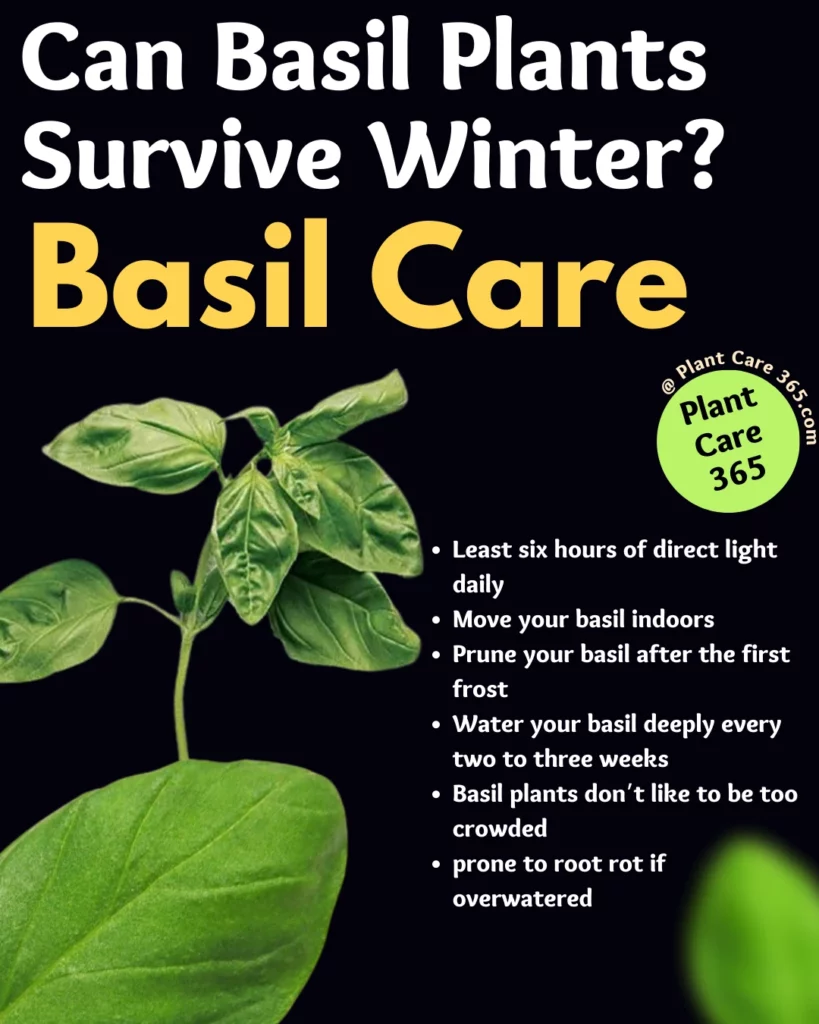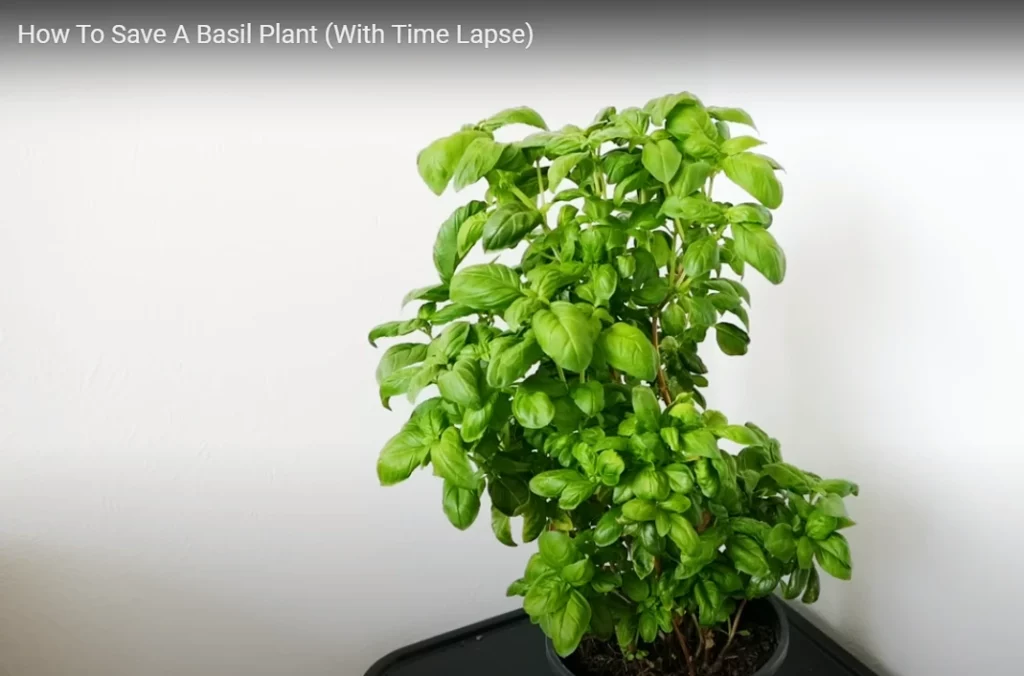Can basil plants survive winter? If you’re a fan of growing basil, you may be wondering if your beloved herb can withstand the cold winter months and fight frost.
Answer In short: Basil is a warm-season herb that prefers temperatures between 60-90°F (15-32°C). It is sensitive to cold temperatures and frost, making it challenging to survive winter conditions. Bringing and growing basil indoors in winter can help them survive.
Contents: How to Grow Basil Outdoors | Growing Basil Indoors | Basil Care for Your Region | Basil Winter Care | Stress Signs on Your Plant | Spring Season Transition
Basil can be grown indoors in pots or containers, placed near a sunny window, or under grow lights to provide sufficient light and warmth.
Winter Plant Care for Basil: Overwintering
Let’s start with the basics: Basil is a tender perennial, meaning it will die off in cold climates with temperatures below 10°F (-12°C). But, with a little bit of winter care, you can give your basil a fighting chance. Here’s what you need to do:
1. Move your basil indoors. If you want to keep your basil alive through the winter, you’ll need to bring it indoors. Ensure to provide your basil with at least six hours of direct light daily. Choose a location that receives ample sunlight, such as a sunny windowsill or near a south-facing window
Related Video: Endless Supply of basil indoors
2. Give Enough Sunlight: If natural light is insufficient, you can supplement it with artificial grow lights to ensure your basil receives the necessary light energy. Avoid exposing the plant to cold drafts or sudden temperature fluctuations
3. Maintain Indoor Humidity Level: Indoor heating during winter can lead to dry air, which can negatively impact your basil plant. To increase humidity, place a tray of water near the plant or use a humidifier to create a more suitable environment
4. Prune your basil. To help your basil survive winter, you’ll want to prune it back to promote vigorous new growth in the spring. Prune your basil after the first frost. Trim any leggy or diseased stems to encourage new growth. Avoid heavy pruning during winter, as the plant’s growth slows down
5. Fertilizer: During winter, basil plants enter a dormant phase, so their nutrient requirements are reduced. Fertilize sparingly or consider suspending fertilization until spring when the plant becomes more active
Save basil growing indoors – Video (Timelapse)
Growing Indoor: Protecting Basil From Cold Weather
6. Water your basil. While basil can survive cold temperatures, it needs to be watered regularly to ensure it gets the nutrients it needs. Water your basil deeply every two to three weeks. Allow the top inch of soil to dry out before watering again.
7. Watch for pests. Pests such as aphids, whiteflies, and mealybugs can damage your basil plant in the winter. Look for signs of infestation and treat your basil if necessary.
8. Harvest before frost: Harvest your basil leaves before the first frost hits. Cut the stems just above a set of leaves, leaving some growth on the plant.
9. Trim the plant: Trim your basil plant down to about 4-6 inches (10-15 cm) in height. This helps reduce the plant’s overall size and conserves energy during the winter months.
10. Transplant to a pot: If your basil is planted in the ground, consider transplanting it into a pot. This allows for easier mobility and protection during winter.
Related: Are basil flowers edible
With a few simple steps, you can ensure your basil plant survives the cold winter months. Taking good care of your basil in the winter will ensure that it’s ready to provide you with a bumper crop of delicious leaves in the spring.
So, don’t let the cold weather keep you from enjoying your favorite herb – follow these steps for winter care and you’ll be sure to have fresh basil all year round!
Bringing Basil Plant Back to Outdoors Spring Transition
- Check the weather forecast: Make sure the temperature outside is consistently above 50°F (10°C) before moving your basil plants outdoors.
- Wait for frost danger to pass: Only transition your basil plants outdoors after the risk of frost has disappeared, typically in late spring or early summer.
- Harden off the plants: Ease your basil plants into outdoor conditions gradually over 7-10 days. Begin by placing them in a sheltered area outside for a few hours a day, then increase the time and exposure to sunlight gradually.
- Prepare the planting area: Clear the planting area of any weeds or debris. Ensure the soil has good drainage and is enriched with organic matter.
- Start in a shaded area: At first, place your basil plants in a spot where they won’t get too much direct sunlight. This area should have some shade to protect them. It’s like giving them a little break from the strong sunlight.
- Increase sunlight exposure slowly: Over the course of about a week or two, slowly let your basil plants spend more time in direct sunlight. Every day, you can give them a little bit more time outside in the sun. This way, they will get used to the bright light and won’t get shocked by it.
Look for Stress Signs: Start Watering and Fertilizers
- Look for signs of stress: Keep an eye on your basil plants to see if they are showing any signs of stress. Signs of stress can include the leaves wilting (getting floppy), turning yellow, or getting burned.
- If you see any of these signs, it means the plants are not ready for that much sunlight yet. Move them back to a partially shaded area and let them adjust more slowly.
- Watering: In the beginning, monitor the soil moisture and water your basil plants as needed. The frequency will depend on the weather and soil conditions. Aim for consistently moist but not waterlogged soil.
- Fertilizing: Once your basil plants have settled into the outdoor environment and are actively growing, you can resume regular fertilization. Use a balanced organic fertilizer or a fertilizer specifically formulated for herbs. Follow the package instructions for application rates and frequency.
Growing Basil Plant Outside (Outdoor)
Basil is a popular herb used for seasoning a variety of dishes, and many home gardeners are curious about whether basil plants can live outside. The answer is yes – but with a few caveats.
Basil plants are sensitive to extreme temperatures, and won’t survive if it’s too hot or too cold. This means you’ll need to choose the best place to plant your basil in order to ensure it has a chance of thriving.
- First, choose a spot in your garden that has good air circulation. Basil plants don’t like to be too crowded, so choose a spot with plenty of space to ensure your basil plants get plenty of sunlight and air.
- Second, select a spot that gets at least six hours of direct sunlight each day. Basil plants need plenty of suns to produce the flavorful leaves that make them so popular.
- Third, choose a spot in your garden that is well-drained. This is especially important if you’re planting basil in a container. Make sure the container has plenty of drainage holes.
- Finally, choose a spot that won’t be overwatered. Basil plants don’t like wet conditions and can be prone to root rot if overwatered. Stick to a regular watering schedule and keep the soil moist.
With these tips in mind, you’ll be able to give your basil plants the best chance of thriving outside. So go ahead, get growing – and enjoy your fresh, tasty basil!
Related: Why plant basil and tomatoes together? and how to save a dying basil plant.
Factors to Consider Before Growin Basil Outdoors:
- Geographic Location: The United States has diverse climates, and basil’s tolerance to winter may vary depending on the region.
- Outdoor or Indoor Growth: Determine whether you plan to grow basil outdoors or indoors during the winter months.
- Frost Protection or Survival: Clarify if you are seeking methods to protect basil from frost or if you are wondering whether basil can survive outside during winter.
Tolerance to Winter and Frost:
- Basil is considered an annual herb and cannot withstand freezing conditions.
- Temperatures below 50°F (10°C) can damage basil plants.
- Freezing temperatures below 32°F (0°C) are especially harmful and may kill the plants.
Steps to Do for Better Survival
- Annual Growth: In regions with freezing winters, grow basil as an annual herb during the warm season and harvest before winter arrives.
- Indoor Cultivation: Consider growing basil indoors in pots or containers near a sunny window or under grow lights to provide sufficient warmth and light during winter.
- Protective Measures: If you experience occasional light frosts, use frost blankets or bring basil plants indoors temporarily during colder nights to protect them from frost.
- Cold-Hardy Varieties: Explore cold-hardy basil varieties like “African Blue Basil” or “Holy Basil” that may have better tolerance to cooler temperatures, but still require protection during freezing conditions.
Growing Basil: Winter Guide for Different Regions
Mild Winter Zones (Zone 8-10):
- These regions generally have mild winters with occasional light frosts.
- Basil can be grown outdoors with protection during frosty nights.
- Consider using frost blankets or row covers to shield basil plants from cold temperatures.
- Ensure the soil is well-drained and provides ample sunlight for optimal growth.
Moderate Winter Zones (Zone 6-7):
- These regions experience colder winters but have milder temperature fluctuations.
- Grow basil as an annual during the warm season and harvest before winter.
- Transition basil indoors to containers or pots near a sunny window during winter.
- Supplement with grow lights to provide sufficient light intensity.
- Maintain consistent moisture levels in the soil and avoid overwatering.
Cold Winter Zones (Zone 3-5):
- These regions have cold winters with prolonged freezing temperatures.
- Grow basil as an annual during the warm season and harvest before frost.
- Opt for indoor cultivation throughout winter using containers and grow lights.
- Provide a warm location for the basil plants, such as near a heat source or a heated greenhouse.
- Monitor humidity levels to prevent dry air from affecting the plants.





